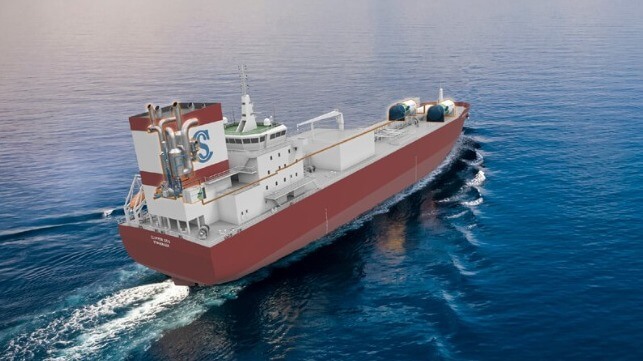Solvang and Wartsila to Test Carbon Capture on Ethylene Carrier

Initial tests in Norway on a carbon capture system designed to separate CO2 gas from a ship’s exhaust have produced encouraging results. According to Norwegian shipowner Solvang, which launched the project last fall with Wartsila, the results show that a “game-changer is within reach.” The companies plan to conduct their first full-scale trial on a vessel this summer and expect to begin testing the full system in 2023.
“There are no easy solutions, so we are looking for the big game-changer,” says Edvin Endresen, CEO at Solvang. He notes that they are building on their 20 years of experience optimizing engine operation, emission cleaning, and exhaust recirculation to benchmark conventional heavy fuel oil (HFO) with LPG, LNG, biofuels, and others in terms of greenhouse gas (GHG) emissions. He says the goal is “to avoid CO2 emissions by means of capture and storage.”
Solvang launched the CCS project for full-scale vessel operations in collaboration with Wärtsilä seeking to leverage the company’s exhaust gas cleaning products. The goal is to capture CO2 from main engine combustion before it passes through the exhaust outlets. A complex carbon separation process takes place inside the smokestack, resulting in liquid CO2 being transferred to deck tanks, ready for long-term storage or industrial reuse.
Testing on the scrubber concept design is running on a 1.2 MW engine in a full-scale test environment at Wärtsilä´s facility in Moss, Norway.
“The system already runs up to 60 percent carbon capture on some engine loads, which has never been done before,” says Endresen. “Furthermore, initial indications are that the CO2 captured is very pure, with little or no product contamination.”
In the second phase of the project, a full-scale version of the system will be installed on ethylene carrier Clipper Eos. Built in 2019 at Hyundai Mipo in South Korea, the 18,056 dwt vessel, which has a capacity of 21,289 cbm of ethylene, operates with a 7 MW main engine. By mid-2022, the plan calls for the installation of an electrostatic filter in the Clipper Eos´ exhaust gas cleaning system.
“The scheduled combination of CCS, scrubber and Solvang´s low-pressure EGR system will handle CO2, NOx, SOx, particles, CO, and unburnt fuel from the HFO combustion. If applied to deep-sea shipping as a sector, it constitutes a great step towards net-zero emission,” states Tor-Øyvind Ask, fleet director at Solvang.
According to the companies, if everything works as planned during the shipboard test, a carbon absorber and stripper units will be installed towards the end of 2023, as well as a modification of liquefaction systems to cater for deck tanks. In the following two years, a complete CCS setup will operate alongside the existing scrubber and exhaust gas cleaning systems onboard the Clipper Eos, providing a steady stream of live data.

that matters most
Get the latest maritime news delivered to your inbox daily.
Several companies have been working to test different versions of carbon capture aboard ships. Last year Japan’s Mitsubishi working with K Line completed what it said was the first successful test on an in-service vessel. The Japanese have also been experimenting with using scrubbers as part of the CCS process and last summer Japan’s National Maritime Research Institute (NMRI), said that it had conducted a test providing real-world validation of results achieved in the lab to extract carbon from a ship’s emissions. Finland’s Langh Tech also tested closed-loop scrubbers that were installed on ships in 2013 and 2014 and by adding additional alkali to the scrubber closed-loop process water provoked a reaction between the alkali and CO2, effectively capturing the CO2 from the exhaust gas into the process water.
